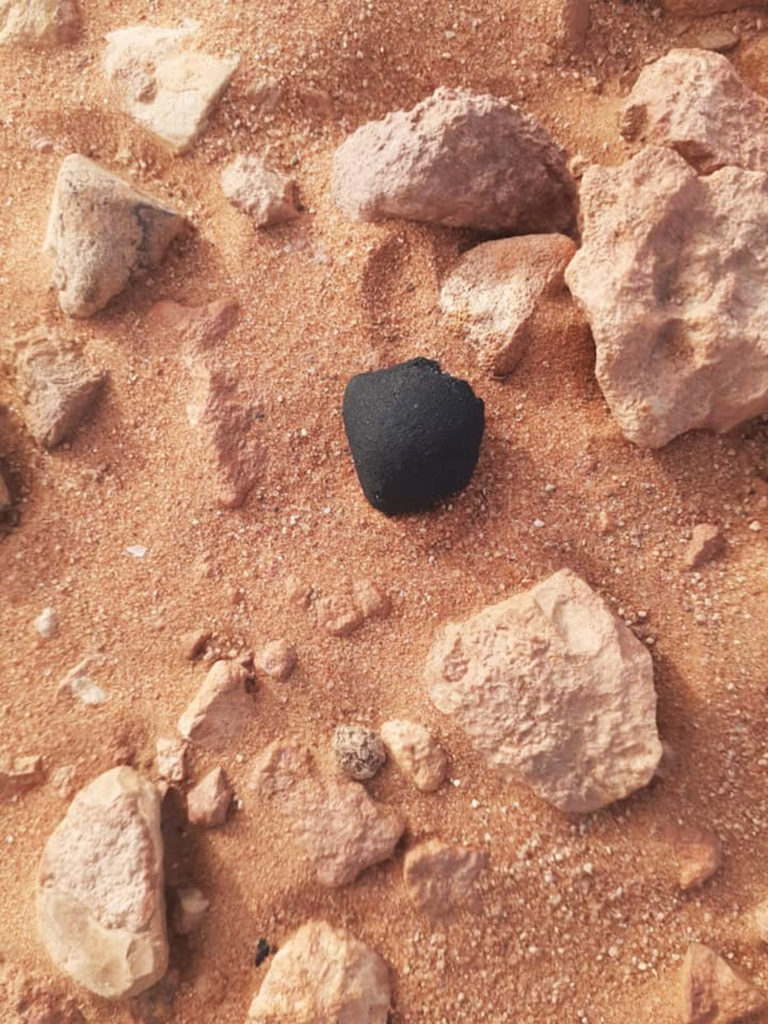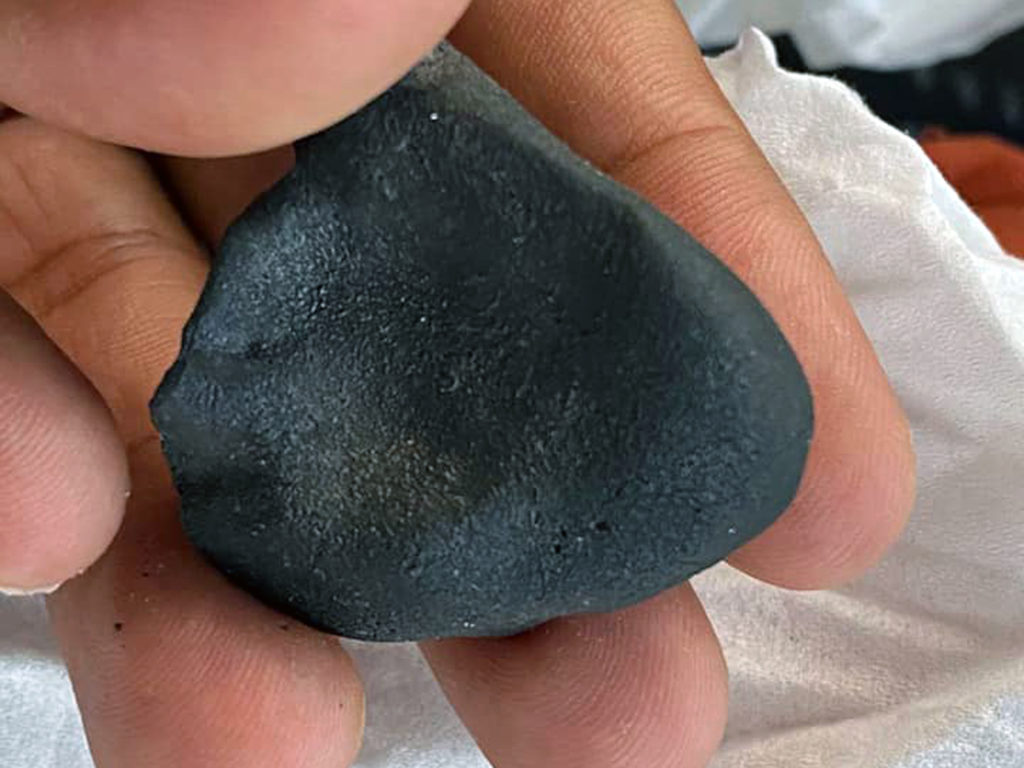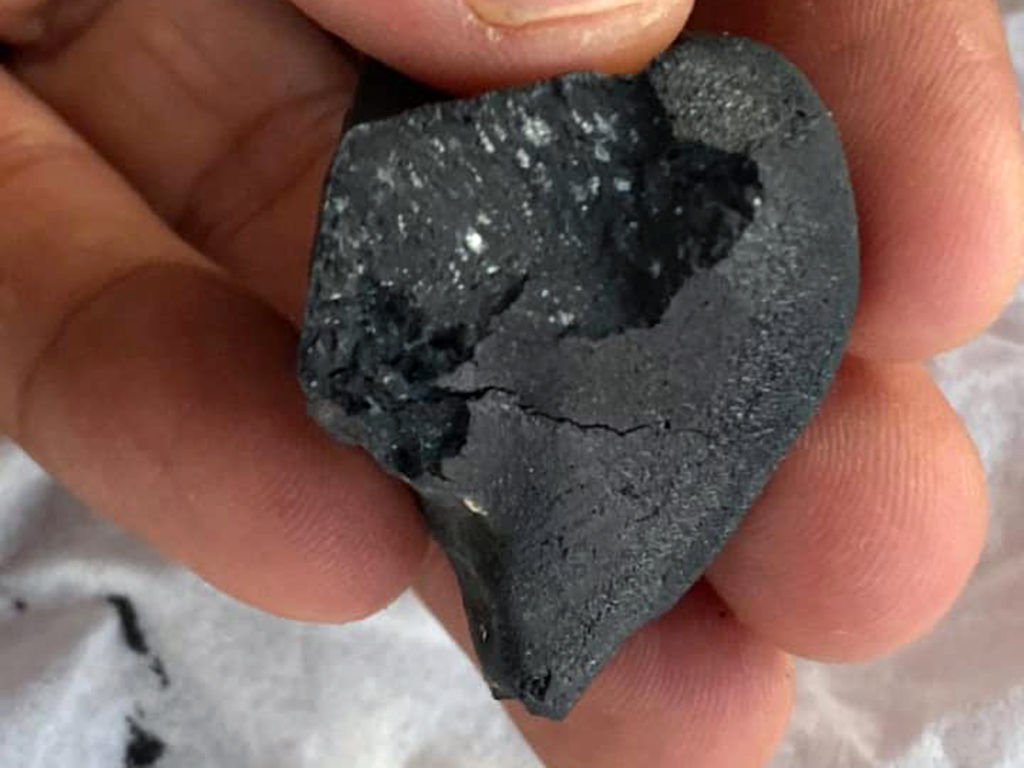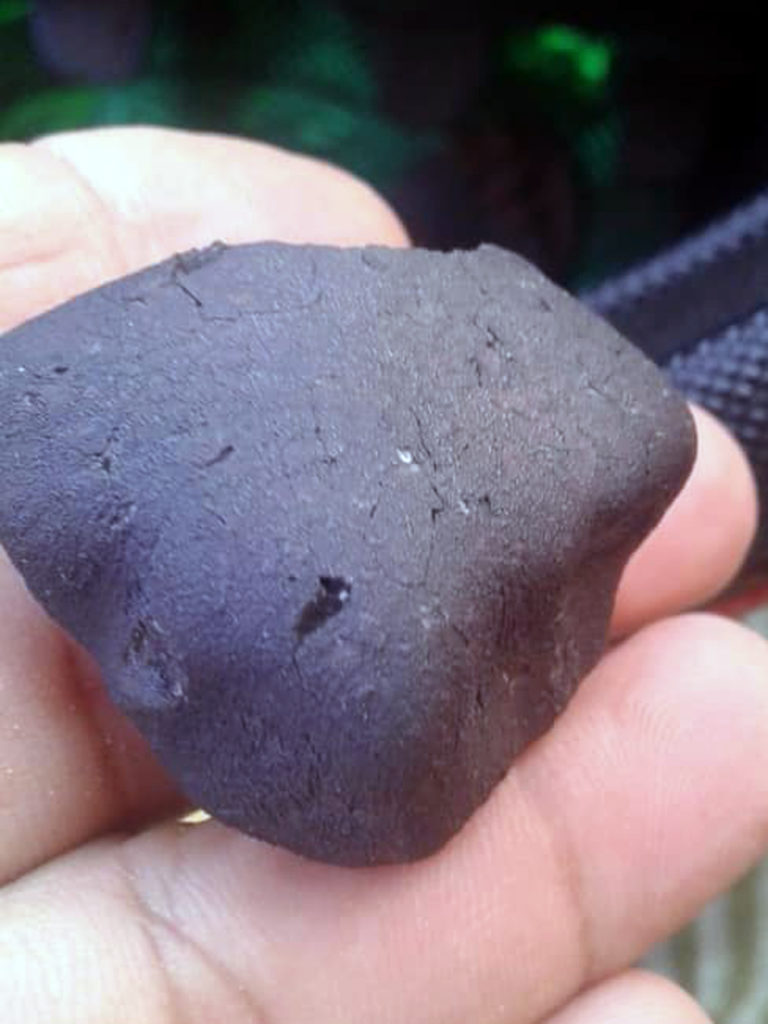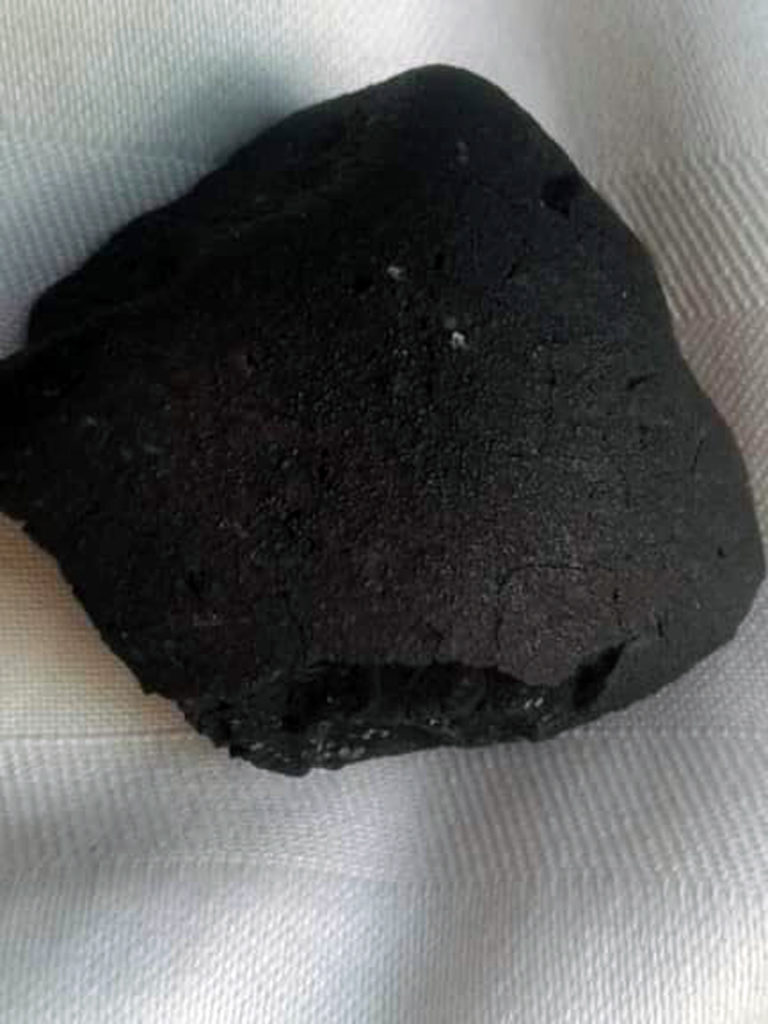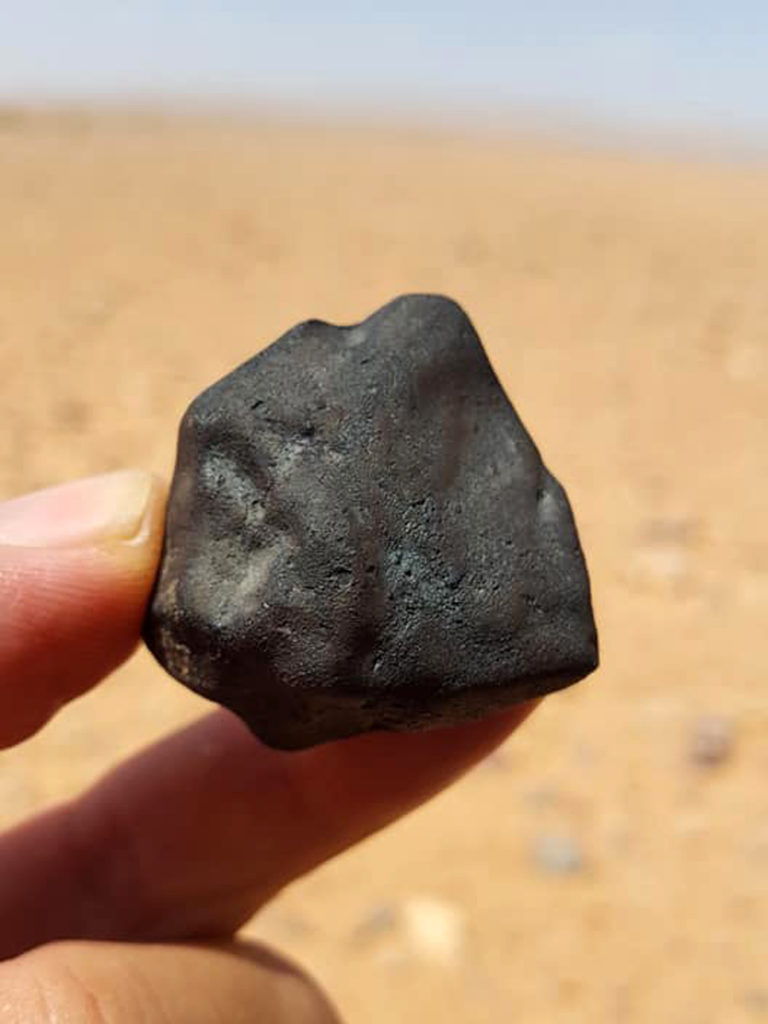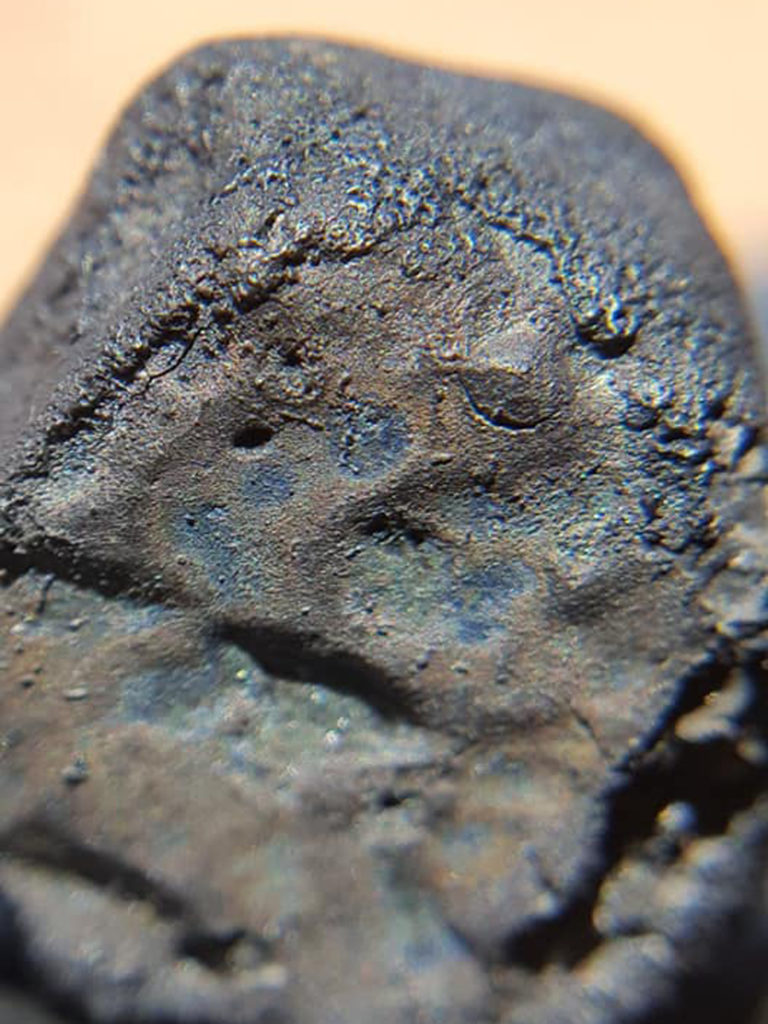TARDA meteorite fall (~ 4 kg, C2-ung) near (Ksar) Tarda (قصر تاردة , ⵜⴰⵔⴷⴰ), near Errachidia ( الرشيدية , ⵉⵎⵜⵖⵔⵏ), Errachidia province, Drâa-Tafilalet, Morocco at ~ 2.30 p.m. (1.30 UT) on 25 August 2020
Last update: 20 May 2021
As first published in social media on 26 August, thousands of smaller masses (mostly below 1 gram, very few between 50 and 99 grams) of rare carbonaceous chondrites (C2-ung) have fallen in a 3-kilometer strewn field in the area west of Ksar Tarda ( قصر تاردة ) southwest of Errachidia (Er Rachidia, الرشيدية , ⵉⵎⵜⵖⵔⵏ) along the N10 to Gulmima ( ڭلميمة ). According to nomads of the Berber tribe ‘Ait Khalifah’ (أيت اخليفة), which live on grazing in the region, an initially blue-orange then reddish fragmenting bolide with green edges, heading from southwest to northeast was observed at ~ 2.30 p.m. (1.30 UT) on 25 August 2020. It left a visible white dust trail which lasted for a few seconds. Additionally, a whistling sound and three loud detonation booms were heard in the area causing panic among the local population in and around Tarda ( قصر تاردة ). At around 11 a.m. on 26 August the first small meteorite specimens were found. The first specimen was found by Alalou Youssef near his village of Tarda. Thousands of meteorite specimens and fragments have been found around location 31°49’35″N, 4°40’46″W . An 86-gram specimen was found at location 31.82648 N, 4.67903 W. A field trip to the strewn field in order to thoroughly document the fall and collect specimens was performed on 27 and 28 August 2020. The field team consisted of Dr Mohamed Aoudjehane, Prof. Faouziya Haissen and Prof. Hasnaa Chennaoui (members of the board of directors of ATTARIK Foundation). It was supported by Prof. Hicham Si Mhamdi (Faculty of Sciences, Errachidia), Adam Aaronson and some members of the Moroccan Association of Meteorites (Ahmed Bouferra, Mohamed and Zaid El Guireh). On 14 October the confirmed fall was officially registered as TARDA (C2-ung) in the database of the Meteoritical Society.

Image: Mustapha Oulkouch

The approximate luminous atmospheric trajectory of the Tarda bolide (yellow arrow, based on eyewitness accounts) and aspects of the Tarda strewn field indicated by the recorded find locations of some individual specimens (red dots). The map is based on information provided by Aoudjehane et al. LPSC21, abstract 1928 (5 February 2021).
MB 109 (14 October 2020):
“Physical characteristics: Hundreds of small to medium-sized fusion crusted stones ranging from 0.1 g to 99 g. The majority of the fusion-crusted stones are <1 g. Some flight-oriented stones show a blue iridescence on their trailing edge, similar to that observed with Aguas Zarcas. Many stones shattered upon impact with the ground. The stones have low density, are somewhat friable, and are particularly susceptible to moisture, and rapidly slake in contact with water or alcohol. Freshly picked up stones were said to have a charcoal-like odor. Small fragments crushed in water emit a powerful tar-like odor. The interiors of the stones are dull black with dispersed white or light-colored grains or clasts (up to ~1 mm in size). Magnetic susceptibility log χ (× 10-9 m3/kg) = 4.99, 4.83, 5.03 (A. Irving, UWS), 4.80 (H. Chennaoui Aoudjehane, FSAC), 4.96 (D. Sheikh, FSU); average 4.92±0.10, n=5.
Petrography: (A. Irving, UWS; P. Carpenter, WUSL; L. Garvie, ASU; D. Sheikh, FSU) Optical and electron microprobe observations of three fragments in polished thin sections reveal a matrix-rich breccia containing small chondrules (granular, BO) and chondrule fragments, very fine grained AOA, grains of forsterite (exhibiting slight undulose extinction) and other clasts set in a dominant fine-grained matrix (~80 vol.%, opaque in thin section). Chondrule sizes measured in two thin sections: 310±150 µm, n=10; 450±200 µm, n=5. No CAIs were identified. The dominant chondrule phase is forsterite (but spinel is present in two examples), and some are mantled by forsterite dust or exhibit partial replacement by Fe-Mn-dolomite, siderite or phyllosilicate material. A single igneous achondrite clast with subophitic texture was observed, and consists predominantly (~75 vol.%) of laths of twinned anorthite with subordinate forsterite, enstatite and minor diopside. Electron microprobe surveys of thin sections and powder X-ray diffraction studies of several ~20 mg fragments show that the matrix is dominated by phyllosilicates, with lesser magnetite, pyrrhotite, pentlandite, troilite, carbonates (Fe-Mn-dolomite, Mg-rich siderite and siderite), and olivine. The phyllosilicates show broad basal reflections at 14.7 Å and 7.4 Å, consistent with smectite and serpentine or interstratified serpentine/smectite, respectively. No reflections for sulfates were recognized. Magnetite (<20 μm) is scattered throughout the sample in the form of framboids, platelets, and individual spherules; other accessory phases identified in the matrix by EPMA are troilite, Ni-bearing pyrrhotite, chromite and very rare kamacite.
Geochemistry: (D. Sheikh, FSU;P. Carpenter, WUSL): Forsterite (Fa1.0±0.6, range Fa0.2-2.9; CaO wt% = 0.2±0.1, range 0.1-0.4; Cr2O3 wt% = 0.51±0.17, range 0.11-0.91; FeO/MnO =10±6, range 3-24; n=35), ferroan olivine (Fa26.5±1.6, range Fa24.8-28.0; CaO wt% =0.2±0.1, range 0.2-0.3; Cr2O3 wt% = 0.44±0.06, range 0.40-0.51; FeO/MnO = 91±7, range 88-99; n=3). Achondrite clast: anorthite (An99.7±0.4, range An99.4-99.9, n=2), forsterite (Fa1.1, FeO/MnO = 7, n=1), enstatite (Fs1.1±0.1 Wo3.2±0.5, range Fs1.0-1.2 Wo2.7-3.7, FeO/MnO = 3, n=3), diopside (Fs1.7 Wo44.0, FeO/MnO = 3, n=1). Bulk composition of the matrix measured using 1 µm-sized beam (in wt%): SiO2= 30.5±6.1, P2O5= 0.1±0.1, Cr2O3= 0.4±0.1, Na2O= 1.0±0.2, TiO2= 0.1±0.1, Al2O3= 2.1±0.5, FeO= 20.2±3.2, MnO= 0.3±0.3, MgO= 19.3±1.8, CaO= 0.5±0.5, K2O= 0.1±0.1, NiO=2.0±1.0, S= 3.5±1.1, Sum 79.8±6.0, n=26. Oxygen isotopes (K. Ziegler, UNM) (linearized, all per mil relative to V-SMOW, TFL slope=0.528): A total of 7 untreated (i.e., no acid-wash) fragments were analyzed by laser fluorination. Sample weights for each measurement were between 2.0 and 4.7 mg. δ18O = 21.971, 17.924, 15.943, 20.842, 16.434, 17.034, 20.607; δ17O = 11.423, 9.124, 7.975, 10.613, 8.277, 8.859, 10.779; Δ17O = -0.178, -0.340, -0.443, -0.391, -0.401, -0.135, -0.102.
Classification: (C. Agee, UNM; K. Ziegler, UNM; A. Irving, UWS; L. Garvie, ASU; D. Sheikh, FSU; P. Carpenter, WUSL; H. Chennaoui Aoudjehane, FSAC; M. Zolensky, JSC; P. Schmitt-Kopplin, HZM) Carbonaceous chondrite (C2-ungrouped). The bulk mineralogy is consistent with a petrologic grade 2, based on the predominance of smectite and serpentine together with the presence of anhydrous mafic silicates, AOA, and chondrules. The oxygen isotopes give a bimodal distribution of the δ18O-values, with one group having values somewhat like those of the CI chondrites, and the other group like values for the Yamato-type (CY) carbonaceous chondrites (King et al., 2019). However, Δ17O values are lower than those for CI and CY chondrites, and plot below the TFL. These isotopic values do not overlap with those of any established carbonaceous chondrite group, hence the ungrouped designation.”

Video: Mustapha Oulkouch
Video: Mustapha Oulkouch
Video: Mustapha Oulkouch
Video: Mustapha Oulkouch
Scientific papers, articles and abstract
The Tarda Meteorite: A Window into the Formation of D-type Asteroids
Yves Marrocchi, Guillaume Avice, and Jean-Alix Barrat
The Astrophysical Journal Letters, Volume 913, Number 1
L. D. Tunney, P. J. A. Hill, C. D. K. Herd, R. W. Hilts, and M. C. Holt
52nd Lunar and Planetary Science Conference (2021), Abstract #1644
Tarda (C2-Ung): A New and Unusual Carbonaceous Chondrite Meteorite Fall from Morocco
Chennaoui Aoudjehane H., Agee C. B., Ziegler K., Garvie L. A. J., Irving A. et al.
52nd Lunar and Planetary Science Conference (2021), Abstract #1928
Exploring the Planetary Genealogy of Tarda — A Unique New Carbonaceous Chondrite
Dey S., Yin Q.-Z., Zolensky M.
52nd Lunar and Planetary Science Conference (2021), Abstract #2517
L. A. J. Garvie, Trif L.
52nd Lunar and Planetary Science Conference (2021), Abstract #2446
Hoffmann V. H., Kaliwoda M., Schmahl W., Wimmer K., Schmitt-Kopplin P.
52nd Lunar and Planetary Science Conference (2021), Abstract #2458
The Bulk Mineralogy and Water Contents of the Carbonaceous Chondrite Falls Kolang and Tarda
King A. J., Bates H. C., Schofield P. F., Russell S. S.
52nd Lunar and Planetary Science Conference (2021), Abstract #1909
Media coverage
Video: 27 August 2020
Video: Chouftv (27 August 2020)
Video: Al Aoula TV (28 August 2020)
Video: ATTARIK Foundation (29 August 2020)
Video: 2M TV (7 September 2020)
Video: Journal, (29 August 2020)
Video: zaid jarrou (29 August 2020)
Video: zaid jarrou (30 August 2020)

